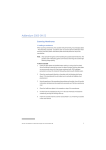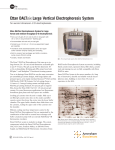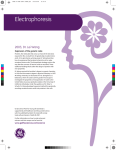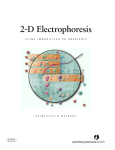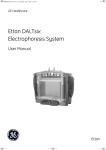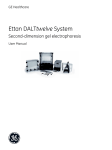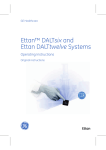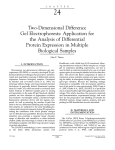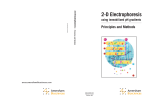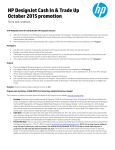Download DIGE Gel and DIGE Buffer Kit - GE Healthcare Life Sciences
Transcript
GE Healthcare DIGE Gel and DIGE Buffer Kit Precast polyacrylamide gels and buffers for 2-dimensional electrophoresis User Manual Important user information All users must read this entire manual to fully understand the safe use of DIGE Gel and DIGE Buffer Kit. WARNING! The WARNING! sign highlights instructions that must be followed to avoid personal injury. Do not proceed until all stated conditions are clearly understood and met. CAUTION! The CAUTION! sign highlights instructions that must be followed to avoid damage to the product or other equipment. Do not proceed until all stated conditions are met and clearly understood. Note The Note sign is used to indicate information important for trouble-free and optimal use of the product. CE Certifying This product meets all requirements of applicable CEdirectives. A copy of the corresponding Declaration of Conformity is available on request. The CE symbol and corresponding declaration of conformity, is valid for the instrument when it is: – used as a stand-alone unit, or – connected to other CE-marked GE Healthcare instruments, or – connected to other products recommended or described in this manual, and – used in the same state as it was delivered from GE Healthcare except for alterations described in this manual. Contents 1 Introduction ...............................................................................5 2 Description of the system .......................................................6 3 Instructions for use...................................................................7 3.1 3.2 3.3 3.4 3.5 3.6 3.7 3.8 3.9 3.10 3.11 3.12 3.13 4 Troubleshooting ......................................................................14 5 Technical information ............................................................17 5.1 5.2 5.3 4 Storage of gels..................................................................................................7 Preparing samples and first-dimension IEF........................................7 Preparing Ettan DALTtwelve electrophoresis unit ...........................7 Preparing Ettan DALTsix electrophoresis unit ...................................8 Equilibrating Immobiline DryStrip gels..................................................9 Applying Immobiline DryStrip gels.......................................................10 Inserting gel cassettes into Ettan DALTtwelve ...............................10 Inserting gel cassettes into Ettan DALTsix........................................11 Recommended running conditions – Ettan DALTtwelve ...........11 Recommended running conditions – Ettan DALTsix....................11 Unloading gels from electrophoresis units ......................................12 Detection..........................................................................................................12 Further analysis of protein spots..........................................................13 Package contents ........................................................................................17 Technical specifications............................................................................18 Recommended equipment, accessories and reagents .............19 DIGE Gel and DIGE Buffer Kit User Manual 28-9460-89 Edition AB Introduction 1 1 Introduction DIGE Gel is a precast polyacrylamide gel for the second dimension of 2-dimensional (2-D) electrophoresis. The gel is cast in a low fluorescent glass cassette that is compatible with 2-D DIGE analysis. The gel size is 255 × 196 × 1 mm. The gel is a homogeneous 12.5% polyacrylamide gel cross-linked with bisacrylamide. It is intended to be used in the Ettan™ DALTtwelve and Ettan DALTsix electrophoresis units together with the DIGE Buffer Kit. The gel is formulated for long shelf-life and, when used with the DIGE Buffer Kit, generates a discontinuous buffer system offering rapid runs with sharp, reproducible results. The performance and capacity of this gel and buffer system are similar to the widely used Laemmli (Tris-glycine) buffer system. This User Manual describes how to use DIGE Gel together with the DIGE Buffer Kit for the second dimension of 2-D electrophoresis. Note: The gels are not bound to the glass, and are intended to be kept in the glass cassettes through electrophoresis and scanning. For preparative gels and consecutive spot picking we recommend the backing-supported DALT gels (17-6002-36) or the Ettan Spot Picker Nonbacked Gel Kit (110002-93), see Section 3.13. DIGE Gel and DIGE Buffer Kit User Manual 28-9460-89 Edition AB 5 Description of the system 2 2 Description of the system DIGE Gel is a precast polyacrylamide gel for the second dimension of largeformat 2-D electrophoresis. It is cast in a low fluorescent glass cassette which is compatible with 2-D DIGE analysis. The gel is intended for use in the Ettan DALTtwelve and Ettan DALTsix electrophoresis units. The gel is used together with the DIGE Buffer Kit, which includes concentrated buffers for running the gel, and Sealing Solution for attaching the IPG strip to the top of the slab gel. Ettan DALTtwelve and DALTsix units are electrophoresis instruments designed for the second dimension of large-format 2-D electrophoresis using either 24 cm or 18 cm IPG strips. The electrophoresis units can accommodate up to 12 gels or up to 6 gels respectively, either precast or lab-cast. The buffer system used in the gel gives longer shelf-life than the conventional Laemmli (Tris-glycine) system while retaining the capacity and robustness of that system. Separations performed using the DIGE Gel are similar to those seen with a 12.5% Laemmli gel. The DIGE Buffer Kit contains all the reagents necessary for a single run of up to 12 DIGE Gels in the Ettan DALTtwelve electrophoresis unit and two runs of up to 6 gels in the Ettan DALTsix electrophoresis unit, see Fig 2-1. Fig 2-1. DIGE Gel and DIGE Buffer Kit. DIGE Gel and DIGE Buffer Kit User Manual 28-9460-89 Edition AB 6 Instructions for use 3 3 Instructions for use WARNING! Always wear gloves, protective clothing, and eye protection when handling DIGE gels, DIGE Buffer, IPG strips, gel cassettes or any other equipment these items will come into contact with. Note: Always use the highest quality reagents and the purest water available. Note: Do not store opened bottles of DIGE Buffer. 3.1 Storage of gels Store the gels horizontally in the original packaging at 4°C to 8°C. 3.2 Preparing samples and first-dimension IEF For instructions in preparing samples for 2-D electrophoresis and running firstdimension IEF, see 2-D Electrophoresis – Principles and Methods (code no. 806429-60 AC) and Ettan DIGE System User Manual (18-1173-17 AB). 3.3 Preparing Ettan DALTtwelve electrophoresis unit Instructions for using Ettan DALTtwelve Electrophoresis Unit can be found in the instrument’s User Manual. 1 In a separate container dilute the concentrated cathode buffer included in the DIGE Buffer Kit to working strength by adding four bottles of DIGE cathode buffer (total volume 500 ml) and fill up with distilled or deionized water to a total volume of 2.25 l. 2 Ensure that the valve on the separation unit is set to “circulate”. Add the entire contents of two bottles of DIGE anode buffer stock solution included in the DIGE Buffer Kit into the tank (see Fig 3-1). Rinse the bottles with distilled or deionized water and pour it into the tank. Fill the tank to the 7.5 l fill line with distilled or deionized water, in this way washing the DIGE anode DIGE Gel and DIGE Buffer Kit User Manual 28-9460-89 Edition AB 7 Instructions for use 3 buffer from the buffer seal. Fig 3-1. Add the anode buffer. Note: Avoid pouring the DIGE anode buffer onto the tubing by spreading the tubing elements apart using one hand while pouring the solution with the other hand. 3 Switch the separation unit on. 4 Turn the pump on to mix, set separation unit to desired temperature. A temperature of 22ºC is recommended for day runs, and 15ºC for overnight runs. 3.4 Preparing Ettan DALTsix electrophoresis unit Instructions for running the Ettan DALTsix electrophoresis unit can be found in the instrument's User Manual. 1 When preparing to run a gel in the DALTsix instrument, insert the anode assembly in the tank and then fill the lower buffer chamber tank. Add one bottle (125 ml) of DIGE Anode Buffer stock solution included in the DIGE Buffer Kit into the tank. Fill the electrophoresis unit to the 4.5 l fill line with distilled or deionized water, and turn the pump on. Note: Use only one bottle of the DIGE Anode (lower) Buffer for each DALTsix run. 2 Turn on the circulation pump. 3 Connect an external MultiTemp™ III thermostatic circulator and set the temperature to 22ºC for a day run and to 15ºC for an overnight run. Equilibrate the buffer to 15ºC before starting an overnight run. DIGE Gel and DIGE Buffer Kit User Manual 28-9460-89 Edition AB 8 Instructions for use 3 3.5 Equilibrating Immobiline DryStrip gels The equilibration step saturates the Immobiline™ DryStrip gel (IPG strip) with the SDS buffer system required for the second-dimension separation. To reduce vertical streaking in the second dimension it is necessary to apply two equilibration steps. The first step saturates the IPG strip with the SDS system and the second step blocks the protein thiol groups. The equilibration solution contains buffer, urea, glycerol, reductant, SDS and dye. Prepare equilibration solution. Prepare SDS equilibration buffer (below). This is a stock solution. Just prior to use, add 50 mg DTT per 10 ml SDS equilibration buffer (0.5% [w/v]). SDS equilibration buffer 1.5 M Tris-Cl pH 8.8 Urea (FW 60.06) Glycerol (87% v/v) SDS (FW 288.38) Bromophenol blue Distilled or deionized water Final concentration Amount 50 mM 6M 30% (v/v) 2% (w/v) 0.001% (w/v) 6.7 ml 72.07 g 69 ml 4.0 g 2 mg to 200 ml Store in 40 ml aliquots at –20ºC. Equilibration. Place the IPG strips in individual tubes with the support film toward the tube wall. Add 10 ml DTT-containing solution to each tube. Place the tubes on a rocker and equilibrate for 15 min. Note: When using CyDye™ DIGE saturation dyes (Labeling Kit for scarce samples), repeat the first equilibration with DTT-containing SDS equilibration solution for another 15 min. Second equilibration. A second equilibration is performed with an iodoacetamide solution (instead of DTT). Prepare a solution of 450 mg iodoacetamide per 10 ml of SDS equilibration buffer (4.5% [w/v]). Decant the first equilibration solution and add the same volume of iodoacetamide containing equilibration solution to each tube. Place the tubes on a rocker and equilibrate for an additional 15 min. Note: The subsequent steps of electrophoresis unit preparation, insertion of gels and melting of the Sealing Solution can be performed while the IPG strips are equilibrating. DIGE Gel and DIGE Buffer Kit User Manual 28-9460-89 Edition AB 9 Instructions for use 3 3.6 Applying Immobiline DryStrip gels Take out the gels from the refrigerator and keep gels at room temperature. Open the gel package and remove the gel. The DIGE gels come in glass cassettes and are ready to be used. Allow the gels to reach room temperature before use. For more information about the application of strips, see Ettan DIGE System User Manual (18-1173-17 Edition AB). 3.7 Inserting gel cassettes into Ettan DALTtwelve When the electrophoresis buffer has reached the desired temperature, insert the loaded gel cassettes with the IPG strips in place. Note: Gel Cassettes and Blank Cassette Inserts slide much more easily into the unit if they are wet. Wetting the cassette with some cathode buffer using a soaked kleenex or alternatively distilled or deionized water from a squirt bottle can be used to wet the cassettes and Blank Cassette Inserts as they are being loaded into the unit. 1 Fit Blank Cassette Inserts into any unoccupied slots. 2 Load the unit from back to front. 3 When all 12 slots are occupied, the buffer level should be slightly below the level of the gaskets. If the buffer level is too low, add distilled or deionized water to the lower buffer chamber. If excess anode buffer is in the upper reservoir, remove it with a pipette. Pour the diluted cathode buffer into the tank to the fill line (some of this buffer may drip through the gasket and mix with the anode buffer during the run, but this will not affect performance or results). DIGE Gel and DIGE Buffer Kit User Manual 28-9460-89 Edition AB 10 Instructions for use 3 3.8 Inserting gel cassettes into Ettan DALTsix When the electrophoresis buffer has reached the desired temperature, insert the loaded gel cassettes with the IPG strips in place. 1 Wet the UBC sealings with cathode buffer or 0.1% SDS (immerse the sealings in solution or spray the sealings of the UBC using a plant sprayer) and carefully slide the UBC over the gel cassettes. Note: Do not move the UBC repeatedly up and down as this will reduce the sealing effect. 2 In a separate container, add 2 × 125 ml (2 bottles) of cathode buffer. Rinse the bottles and fill up with distilled or deionized water to 1.2 l. 3 Fill the UBC with 1.2 liters of diluted cathode buffer and use a funnel to adjust the buffer level in the lower buffer chamber to the same height as in the UBC, by adding water or diluted anode buffer. 3.9 Recommended running conditions – Ettan DALTtwelve Program the Ettan DALTtwelve electrophoresis unit to deliver the following protocol. Constant power Temperature: 22°C Phase Power W/gel Duration 1 2 1W 1 17 W (max 180 W) 1 hour Until the bromophenol dye front reaches the bottom of the gel (approximately 4-5 hours for a full set of 12 gels). 1 For overnight runs, the power is set to 1 W/gel and the recommended temperature is 15ºC. Alternatively, set the temperature to 22ºC. Run for 1 hour and then increase to 1.5 W/gel. 3.10 Recommended running conditions – Ettan DALTsix The maximum rated electrical input for the electrophoresis unit is 400 mA, 100 W, and 600 V. For overnight runs we recommend to set the temperature to 15ºC. Alternatively, set the temperature to 22ºC. For further run conditions, see the DIGE Gels and DIGE Buffer Kit Short Instructions (28-9460-86) in the DIGE Buffer Kit. DIGE Gel and DIGE Buffer Kit User Manual 28-9460-89 Edition AB 11 Instructions for use 3 Run conditions (Day run): Set the MultiTemp temperature to 22ºC. Step mA/gel Voltage (V) W/gel Time (hours:mins) 1 2 10 50 80 500 1 2 17 1:0 3 4:00-5:00 2 3 The maximum rated input power for the electrophoresis unit is 100 W. Continue the electrophoresis until the bromophenol blue reaches the end of the gel. Run Conditions (Overnight): Set the MultiTemp temperature to 15ºC. Step mA/gel Voltage (V) W/gel Time (hours:mins) 1 12 150 1.5 15:00-17:00 4 4 Continue the electrophoresis until the bromophenol blue reaches the end of the gel. 3.11 Unloading gels from electrophoresis units For information regarding unloading gels from the electrophoresis units, please refer to the respective instrument User Manuals. The gels should not be removed from the cassettes. 3.12 Detection Scan the gels as soon as possible after the second dimension SDS-PAGE is finished in order to minimize protein diffusion. Typhoon™ Variable Mode Imager or Ettan DIGE Imager are recommended for scanning DIGE second dimension SDS-PAGE gels. Store the gels in a refrigerator in a closed container and keep the gels moist. Allow the gels to reach room temperature before scanning. Keep the gels in the glass cassettes throughout scanning. DIGE Gel and DIGE Buffer Kit User Manual 28-9460-89 Edition AB 12 Instructions for use 3 3.13 Further analysis of protein spots For preparative gels and consecutive spot picking, the backing-supported DALT gels (17-6002-36) and the DALT Buffer Kit (17-6002-50) can be used. CyDye DIGE fluor minimal dye Cy™5 can be included for matching and detection purposes. Alternatively, the non-supported DIGE gels can be used with the Ettan Spot Picker Nonbacked Gel Kit (11-0002-93). DIGE gels can be removed from the glass cassettes for staining or Western Blotting. To open the cassette, use a spatula to remove the glue at one side of the cassette. Open carefully to avoid damaging the gel. Adding small amounts (ml) of water or buffer on top of the gel will aid the opening process. With the gel positioned on one glass plate the DIGE gel can be easily moved to a tray for post-staining, e.g. using Deep Purple™. Please note that the gel is not attached to a glass plate. DIGE Gel and DIGE Buffer Kit User Manual 28-9460-89 Edition AB 13 Troubleshooting 4 4 Troubleshooting This section concerns troubleshooting problems that have their origin in the second-dimension separations using DIGE Gel. For a more comprehensive guide to troubleshooting problems with 2-D electrophoresis, see 2-D Electrophoresis Using Immobilized pH Gradients – Principles and Methods (80-6429-60). Symptom No current at start of run Buffer not circulating (Ettan DALTsix only) Seconddimension separation proceeds slowly with high current (Ettan DALTtwelve only) Possible cause Remedy Insufficient volume of buffer in upper reservoir. Pump is not primed. Ensure that the upper reservoir contains enough buffer to contact the upper electrode. Turn pump off and on to purge air bubbles. Pump is off. Turn pump on. Pump is broken. Call for service. All the slots in the Ensure that all 12 slots in the sealing sealing assembly are assembly are occupied. not occupied by either gel cassettes or Blank Cassette Inserts. Anodic buffer has mixed with cathodic buffer from overfilling of either the cathodic reservoir or the anodic reservoir. DIGE Gel and DIGE Buffer Kit User Manual 28-9460-89 Edition AB Do not pour more than the suggested volume (7.5 l) into the lower reservoir. Ensure that the level of the anode buffer does not come above the sealing assembly when the electrophoresis unit is fully loaded. If excess anode buffer is in the upper reservoir, it should be removed with a pipette. Ensure that the level of cathode buffer does not come above the air vents in the corners of the upper reservoir. Lack of mixing between upper and lower reservoirs can be verified by adding bromophenol blue dye to the lower reservoir prior to loading the unit with gels. Several drops of 1% (w/v) bromophenol blue will impart sufficient color to the anode buffer. 14 Troubleshooting 4 Symptom Seconddimension separation proceeds slowly with high current (Ettan DALTsix only) Dye front is irregular Possible cause Remedy One of the slots in the All six slots in the upper buffer upper buffer chamber chamber must be occupied by either a is open. gel cassette or a blank cassette. Upper buffer chamber is damaged. Anodic buffer has mixed with cathodic buffer from overfilling of either the cathodic reservoir or the anodic reservoir. The top surface of the gel has been damaged during application of the IPG strip. Change upper buffer chamber. Ensure that the level of the anode (lower) buffer does not come above the level of the buffer in the upper buffer chamber when the electrophoresis unit is fully loaded. Take care during application of the IPG strip that the gel is not damaged. Interfering substances Contaminants in the sample can in the first dimension. cause distortions or swollen regions in the IPG strip following IEF. These distortions can result in disturbances in the second dimension. Modify sample preparation to limit these contaminants. Refer to 2-D Electrophoresis Using Immobilized pH Gradients – Principles and Methods (code no. 80-6429-60) for suggestions. Distortion in the Interfering substances Contaminants in the sample can 2-D pattern in the first dimension. cause distortions or swollen regions in the IPG strip following IEF. These distortions can result in turn in disturbances in the second dimension. Modify sample preparation to limit these contaminants. Refer to 2-D Electrophoresis Using Immobilized pH Gradients –Principles and Methods (code no. 80-6429-60) for suggestions. DIGE Gel and DIGE Buffer Kit User Manual 28-9460-89 Edition AB 15 Troubleshooting 4 Symptom Vertical gap in the 2-D pattern Possible cause Bubble between IPG strip and top surface of second dimension gel. Remedy Ensure that no bubbles are trapped between the IPG strip and the top surface of second-dimension gel. Vertical streaking Incorrectly prepared Prepare equilibration solution equilibration solution. according to instructions. Poor transfer of Employ a low power or current protein from IPG strip sample entry phase in the secondto second gel. dimension electrophoresis run. Prolong entry phase if necessary. Insufficient Prolong equilibration time. equilibration. Equilibrate IPG strip in two steps. 1st IPG strip was not equilibrated with step with DTT (0.5%) and 2nd step iodoacetamide in a with iodoacetamide (4.5%) second equilibration according to instructions on page 9. step. IPG strip is not placed Ensure that the plastic backing of Spots are properly. vertically douthe IPG strip is against the glass bled, or plate of the second dimension “twinned” cassette. Incorrectly prepared Prepare equilibration solution Poor representation of equilibration solution. according to instructions. higher molecular weight proteins Poor transfer of protein Employ a low power or current from IPG strip to sample entry phase in the secondsecond-dimension gel. dimension electrophoresis run. Prolong entry phase if necessary. Bubbles lagging These bubbles do not affect the after the front result. DIGE Gel and DIGE Buffer Kit User Manual 28-9460-89 Edition AB 16 Technical information 5 5 Technical information 5.1 Package contents DIGE Gel Each gel package contains three gels. Designation No. per pack Code No. DIGE Gel 3 28-9374-51 DIGE Buffer Kit Each kit contains 6 bottles of buffer, 12 tubes of sealing solution, and the Short Instruction. The solutions are sufficient for a single run of up to 12 gels or two DALTsix runs. Designation No. per pack Code No. DIGE Buffer Kit Sufficient to run 12 gels 28-9374-52 Contains: Anode Buffer Cathode Buffer Sealing Solution DIGE Gel and DIGE Buffer Kit User Manual 28-9460-89 Edition AB 2 bottles (2 × 125 ml) 4 bottles (4 × 125 ml) 12 tubes (12 × 1 ml) 17 Technical information 5 5.2 Technical specifications DIGE Gel Gel composition Separation range Gel dimensions Buffer in gel Gel cassette Shelf life Storage T = 12.5%, C = 3% (12.125% acrylamide, 0.375% bisacrylamide) 12–120 kDa 255 × 196 × 1 mm Special buffer based on piperidinopropionamide (PPA) Low fluorescent glass 12 months 4°C to 8°C DIGE Buffer Kit Anode Buffer (2 bottles) Special buffer based on piperidinopropionamide (PPA) Cathode Buffer (4 bottles) 0.25 M Tris, 1.92 M glycine, 1% (w/v) SDS Sealing Solution Gel Buffer with 0.5% agarose and 0.002% bromophenol blue Shelf life Estimated 12 months Storage 4°C to 8°C DIGE Gel and DIGE Buffer Kit User Manual 28-9460-89 Edition AB 18 Technical information 5 5.3 Recommended equipment, accessories and reagents Designation Code No. Ettan DALTtwelve Separation Unit and Power Supply/Control Unit, 230 VAC Ettan DALTtwelve Separation Unit and Power Supply/Control Unit, 115 VAC Ettan DALTsix Electrophoresis Unit including buffer circulation pump and Peltier cooling, 230 VAC Ettan DALTsix Electrophoresis Unit including buffer circulation pump and Peltier cooling, 115 VAC MultiTemp III Thermostatic Circulator, 115 V MultiTemp III Thermostatic Circulator, 230 V EPS 601 Power Supply DALT Blank Cassette Insert Cassette Rack PlusOne Urea PlusOne Tris PlusOne Glycerol PlusOne Dithiothreitol PlusOne Sodium Dodecylsulfate PlusOne Bromophenol Blue Equilibration Tube Set (12/pk) 80-6466-27 Immobiline DryStrip pH interval 3.5–4.5 3–7 NL 4–7 6–9 6–11 3–10 3–10 NL 3–5.6 NL 5.3–6.5 6.2–7.5 7–11 NL 3-11 NL 80-6466-46 80-6485-27 80-6485-08 18-1102-77 18-1102-78 18-1130-02 80-6467-03 80-6467-98 17-1319-01 17-1321-01 17-1325-01 17-1318-01 17-1313-01 17-1329-01 80-6467-79 Dry polyacrylamide gels (0.5 mm, T = 4%, C = 3%, after rehydration) cast on plastic backing. 12/pk Code No. / 18 cm strip 17-1233-01 17-6001-88 17-6001-97 17-1234-01 17-1235-01 17-6003-56 17-6003-61 17-6003-66 17-6003-71 17-6003-76 DIGE Gel and DIGE Buffer Kit User Manual 28-9460-89 Edition AB Code No. / 24 cm strip 17-6002-38 17-6002-43 17-6002-46 17-6002-47 17-6002-44 17-6002-45 17-6003-57 17-6003-62 17-6003-67 17-6003-72 17-6003-77 19 For local office contact information, visit www.gelifesciences.com/contact GE Healthcare Bio-Sciences AB Björkgatan 30 751 84 Uppsala Sweden www.gelifesciences.com/proteomics GE, imagination at work and GE monogram are trademarks of General Electric Company. Cy, CyDye, Deep Purple, Ettan, Immobiline, MultiTemp and Typhoon are trademarks of GE Healthcare companies. All third party trademarks are the property of their respective owners. © 2009 General Electric Company – All rights reserved. First published Oct. 2008. CyDye: This product or portions thereof is manufactured under an exclusive license from Carnegie Mellon University under US patent number 5,268,486 and equivalent patents in the US and other countries. 2-D Fluorescence Difference Gel Electrophoresis: 2-D Fluorescence Difference Gel Electrophoresis (2-D DIGE) technology is covered by US patent numbers 6,043,025, 6,127,134 and 6,426,190 and equivalent patents and patent applications in other countries and exclusively licensed from Carnegie Mellon University. CyDye: this product or portions thereof is manufactured under an exclusive license from Carnegie Mellon University under US patent numbers 5,569,587, 5,627,027 and equivalent patents in other countries. The purchase of CyDye DIGE Fluors includes a limited license to use the CyDye DIGE Fluors for internal research and development, but not for any commercial purposes. A license to use the CyDye DIGE Fluors for commercial purposes is subject to a separate license agreement with GE Healthcare. All goods and services are sold subject to the terms and conditions of sale of the company within GE Healthcare which supplies them. A copy of these terms and conditions is available on request. Contact your local GE Healthcare representative for the most current information. GE Healthcare Europe GmbH Munzinger Strasse 5 D-79111 Freiburg Germany GE Healthcare UK Limited Amersham Place Little Chalfont Buckinghamshire, HP7 9NA UK GE Healthcare Bio-Sciences Corp 800 Centennial Avenue P.O. Box 1327 Piscataway, NJ 08855-1327 USA GE Healthcare Bio-Sciences KK Sanken Bldg. 3-25-1 Hyakunincho, Shinjuku-ku Tokyo 169-0073 Japan imagination at work 28-9460-89 AB 03/2009





















